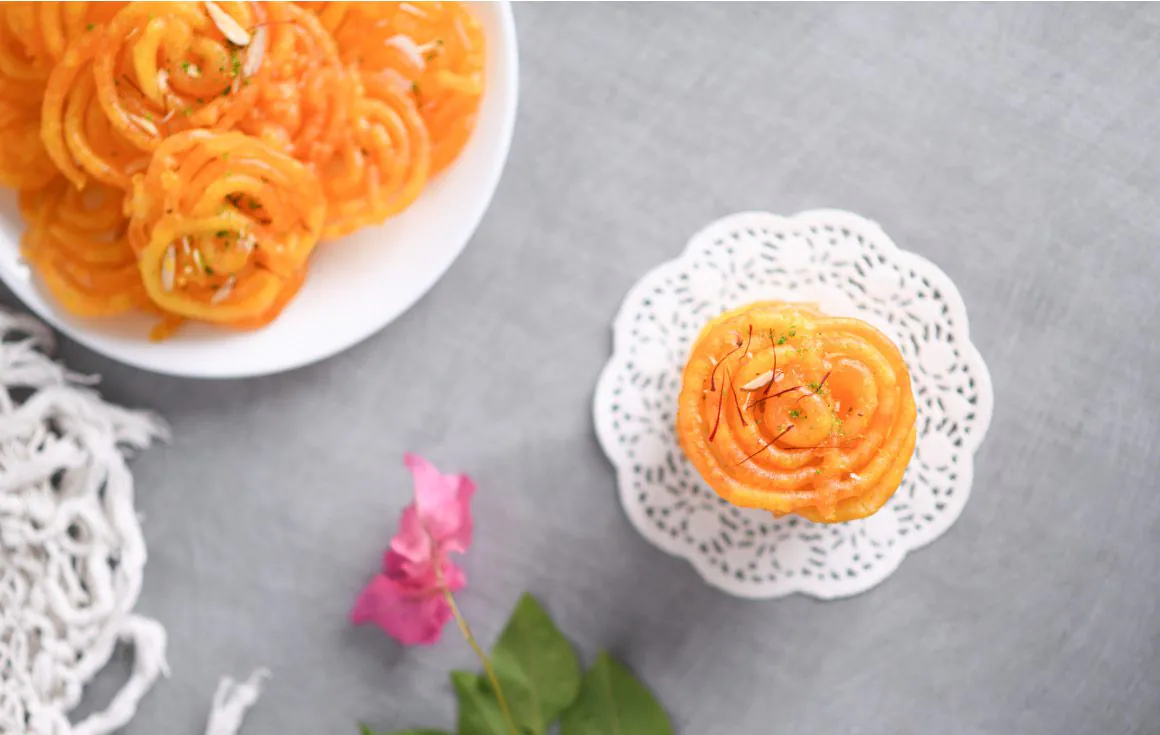If you are not a Jalebi fan, we cannot be friends.
Whether you eat it for breakfast of puri and aloo ki sabzi or as an evening snack of Samosa and chai, whether it’s just on its own or with curd, whether it’s hot, cold, or even daylong stale, it will still be the highlight of your day!
Did you know that this famous delicacy doesn’t originate from India? The nation’s beloved recipe is taken from its Middle-Eastern counterpart Zalabiya or the Persian Zulbiya!
Even though there are differences between the two, this recipe was brought to the Indian subcontinent by Persian traders, artisans, and Middle Eastern invaders during the medieval period. It began to be known as Jalebi, a local pronunciation of Zaalabia. By the 15th century, Jalebi became a must for festive occasions, weddings, temple food, or just comfort food.
With more than 500 years of history in the recipe, this spiral-shaped delight is prepared with a batter made with all-purpose flour (maida), cardamom powder, and Kesar, which is deep-fried to golden-brown color, and soaked in the sugar syrup with hints of saffron, for the perfect hue. This finger-licking dish has a chewy texture with a crystallized sugary exterior coating.
It is often served with curd, rabdi or milk, there are various types of jalebis that you should definitely try!
Particularly famous in the state of West Bengal, Paneer Jalebi or Chennar Jilipi is made out of cottage cheese. Paneer Jalebi is darker and crispier than the classic Jalebi and is also a healthier alternative.
Another popular jalebi comes from Madhya Pradesh, Khoya Jalebi is made with a mixture of Khoya, maida, and milk. Khoya Jalebi is moreish and has a different texture and thickness than the classic jalebi.
And my personal favourite is the North Indian version of Jalebi which is made using Urad dal, Otherwise known as Jhangiri, this type of Jalebi is made by frying the batter in flower patterns and is served as it is.
All this talk about Jalebi is making me want to eat some hot jalebis with thick curd. It’s easy to make at home if you want to give it a try yourself!
Let me share with you how to make a Jalebi Recipe At Home by Chef Sanjeev Kapoor that I use whenever I get this craving for jalebis!
Ingredients
1/2 cup maida (refined flour)
1/4 cup dahi (yogurt, preferably sour)
Oil/ghee (for frying)
A square piece of cloth with a hole in it, or a strong plastic bag for piping out the ‘jalebis’
1 cup sugar
1 cup water
Let’s make it!
- Mix the flour and dahi to form a thick smooth paste (dropping consistency), add water if necessary and leave to ferment for 6-7 hours (time depending on the weather).
- When the batter is ready, it should be spongy and you should be able to see bubbles on the surface.
- Make the sugar syrup by dissolving sugar and saffron in the water over low heat, then cook over high heat till slightly thick.
- When this mixture is lifted with a spoon and poured back into the pan, it should fall in a thin smooth stream, or when a drop of it is cooled a little, press it between your thumb and forefinger and then pull the fingers apart, it should be thread-like. Keep warm, till you fry the ‘jalebis’.
- Take a shallow, heavy pan and heat the ghee/oil. To test if your oil is ready, drop in a little bit of batter in the oil, and see if it comes up at once. If it does, your oil is ready for frying.
- Fill the bag with the batter. Twist the opening to seal the bag. Snip one lower corner of the bag to make a small hole, through which you can pipe out the `jalebis’. The smaller the hole, the thinner the jalebis.
- Hold the bag over the hot oil and pipe out swirls (like whirlpools), of the desired size, straight into it. Make as many such rounds as come in comfortably without touching each other.
- Lower the heat to medium turn the ‘jalebis’ over and fry till a light brown on both sides.
- Lift out the fried jalebis, drain out the oil, and put them into the syrup. Leave it for a minute or so, and then again lift it out.
Serve it hot in front of your family members and friends.

